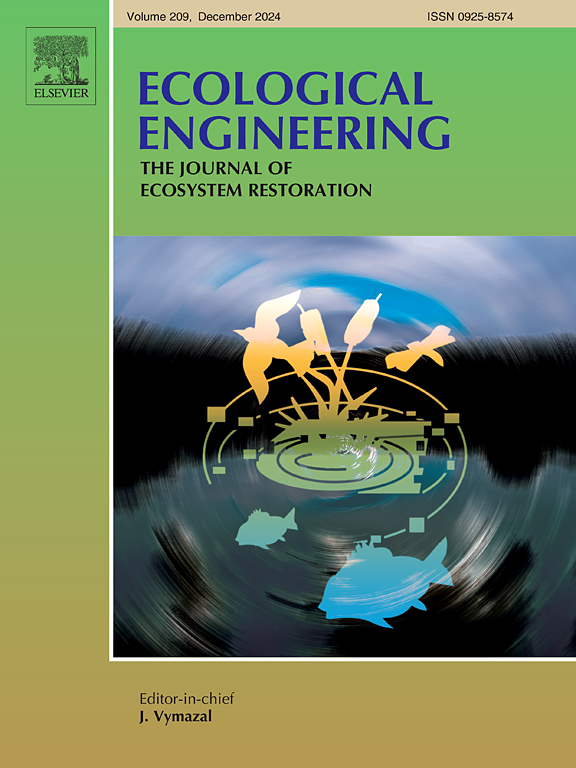典型绿洲-荒漠交错带12年围篱后土壤性质和植物群落的变化
IF 4.1
2区 环境科学与生态学
Q1 ECOLOGY
引用次数: 0
摘要
放牧是干旱绿洲-荒漠过渡带植被退化和土壤侵蚀的主要原因。围栏已成为促进物种多样性恢复和植物群落稳定的最重要措施。本研究分析了河西走廊典型荒漠绿洲过渡带在连续封篱12年后土壤理化性质、植物多样性、生态位宽度和重叠度、种间关联和群落稳定性的变化。有效养分,特别是有效氮,在围栏期间显著增加。土壤有机质和全氮含量变化不显著。在灌丛层,优势种由白刺向白刺与松木的组合再向松木的组合转变。这种转变可能是由更多的氮可用性驱动的。草本层的优势种由早期(2 ~ 4年)的长叶刺槐和青花蒿(Suaeda glauca)转变为中期(5 ~ 8年)的猪毛蒿(Artemisia scoparia),后期(9 ~ 10年)的小灰苔(Eragrostis minor)。封育前后群落多样性呈先增加后减少的趋势。从第6年开始,松木白刺的生态位重叠值显著高于白刺。经过12年的封禁,松鸡成为了关键种,松鸡的恢复增加了种间负相关关系。这些发现表明,经过12年的围栏,土壤和植被仍处于过渡阶段,这表明沙漠生态系统需要更长的时间才能完全恢复。本文章由计算机程序翻译,如有差异,请以英文原文为准。
Changes in soil properties and plant community following twelve years of fencing in a typical oasis–desert ecotone
Livestock grazing is the main cause of vegetation degradation and soil erosion in arid oasis–desert ecotones. Fencing has become the most important measure to promote the recovery of species diversity and plant community stabilization. In this study, we analyzed the changes in soil physical–chemical properties and plant diversity, niche width and overlap, inter-species associations, and community stability in a typical desert oasis ecotone of the Hexi Corridor in Northwest China following 12 years of continuous fencing. Available nutrients, particularly available nitrogen, increased significantly over the fencing period. However, no significant changes were observed in soil organic matter or total nitrogen. In the shrub layer, the dominant species shifted from Nitraria sphaerocarpa to a combination of Nitraria sphaerocarpa and Reaumuria songarica and then Reaumuria songarica. This shift was likely driven by greater nitrogen availability. In the herbaceous layer, the dominant species changed from Zygophyllum mucronatum and Suaeda glauca in the early stage (2–4 years) to Artemisia scoparia in the middle stage (5–8 years), and to Eragrostis minor in the late stage (9–10 years). The community diversity showed an increasing and then decreasing trend with 12 years of fencing. The niche overlap value for Reaumuria songarica was significantly higher than Nitraria sphaerocarpa from the sixth year. Reaumuria songarica became the keystone species after 12 years of fencing, and the recovery of Reaumuria songarica increased negative interspecific associations. These findings suggest that after 12 years of fencing, the soil and vegetation remain in a transitional phase, indicating that desert ecosystems require extended periods for full recovery.
求助全文
通过发布文献求助,成功后即可免费获取论文全文。
去求助
来源期刊

Ecological Engineering
环境科学-工程:环境
CiteScore
8.00
自引率
5.30%
发文量
293
审稿时长
57 days
期刊介绍:
Ecological engineering has been defined as the design of ecosystems for the mutual benefit of humans and nature. The journal is meant for ecologists who, because of their research interests or occupation, are involved in designing, monitoring, or restoring ecosystems, and can serve as a bridge between ecologists and engineers.
Specific topics covered in the journal include: habitat reconstruction; ecotechnology; synthetic ecology; bioengineering; restoration ecology; ecology conservation; ecosystem rehabilitation; stream and river restoration; reclamation ecology; non-renewable resource conservation. Descriptions of specific applications of ecological engineering are acceptable only when situated within context of adding novelty to current research and emphasizing ecosystem restoration. We do not accept purely descriptive reports on ecosystem structures (such as vegetation surveys), purely physical assessment of materials that can be used for ecological restoration, small-model studies carried out in the laboratory or greenhouse with artificial (waste)water or crop studies, or case studies on conventional wastewater treatment and eutrophication that do not offer an ecosystem restoration approach within the paper.
 求助内容:
求助内容: 应助结果提醒方式:
应助结果提醒方式:


